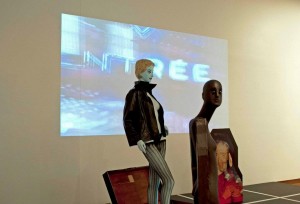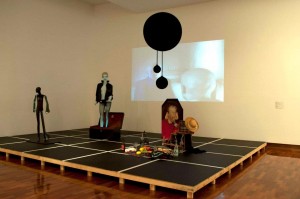I know, because the writing on the wall told me, that this installation is somehow the restaging of a play written by Pablo Picasso. I do not feel it is necessary to know the event passed in order to situate myself into the present work but I can’t help wondering. So I do it. I go to Google. But only later, at the end, when I am trying my best to assimilate the various perceptions I have gleaned and tried to extract from the work.
Now it strikes me quite fittingly that this milieu is at odds with a performative piece that is the original play. Yes, there is movement in the form of a video piece, but it is recorded. It is so unlike theatre, which is live and unique and ephemeral. In contrast Bertoli beckons you into a trance or a time-loop.
The work is literally and intentionally a pastiche—but the pastiche is heightened by Bertoli’s impromptu selection of objects and materials.
The projection layers imagery that is idealised and filtered by nostalgia: pictures of mundane urban streets, surreal kitsch eroticism, impenetrable esoterica and possibly a place—somewhere in Europe or maybe Paris. Its aesthetic and haunting discordant soundtrack remind me of the film Cuadecuc, Vampir by Pere Portabella: a sort of documentary of an event, stealing scenes from the feature being shot around it—the filming of Jesus Franco’s Count Dracula. Portabella’s film has parallels with Bertoli’s ensemble installation as well. Although it was made at precisely the same time as the event it was referencing, it also does not attempt to contextualise events or create a linear narrative and like Bertoli’s video footage it contains no real dialogue.
Bertoli’s accompanying photographic montages serve as reference points to the video and the sculptural installation. They show a motley bunch of characters on a stage yet on a flat plane. They are not in any particular spatial dimension and for the most part are independent of one another.
The installation of sculptures and found objects, set in the centre of a black stage marked-out with a white grid is static, an inert panorama reminiscent of a museum display, disjointed—join the dots, if you can.
The mannequin standing upright in a trunk recalls a character from the images. It reminds me of a crime scene investigation. A mannequin becomes a proxy for the missing one, roadside at the point of ‘departure’ dressed in the victim’s clothing in order to trigger memories.
Post-planning: Damiano Bertoli, Julian Hooper, Andrew Hurle, Alex Martinis Roe, Michelle Nikou, Ian Potter Museum of Art, University of Melbourne, 31 March – 22 July 2012.



